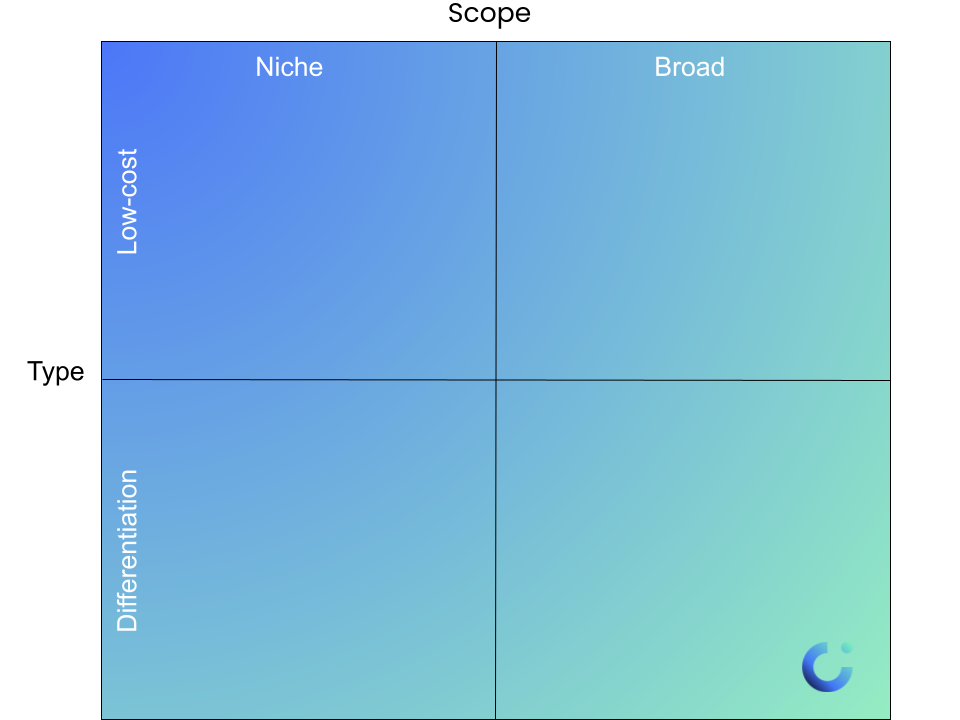What is a niche strategy?
A niche business strategy is one that sees you targeting a particularly small subset of consumers. Rather than trying to be everything to everyone, you aim to provide the best solution for a small group of people.
Make sense? So, rather than targeting all guitar players, for example, a business with a niche strategy for selling its guitar strings might target:
- Jazz guitar players,
- Between the ages of 30 and 49,
- With a preference for hollow body guitars.
Notice how, here, there are three elements to the market segment the guitar string business chooses to target. This makes the segment specific.
Contrast it with the other guitar string business, aiming to produce an all-purpose set of strings suitable for all players and all types of guitars.

Specialism and disqualification:
Our example guitar string maker, with the niche market strategy, positions itself as a specialist, and an expert provider of guitar strings for its target audience.
But it also takes advantage of a trope used in copywriting all the time: disqualification.
The more specific you can be, the more polarizing you’ll be to your audience. Inherently, you’re making it so your message (or your product) is very much not relevant to a majority of people. These people lose interest very quickly.
But the remaining minority? These people are your target audience. They feel your message, or your product, was crafted specifically for them. They get excited when they learn about it, and how it ticks all of their boxes.
This is what a good niche strategy (a good niche differentiation strategy, specifically) does for you.
Niche vs. focus strategies
“Niche strategies” aren’t all that different from the “focus strategies” Michael Porter talks about. Porter suggested a four-part model of possible competitive strategies, two of which were the “differentiation” and “differentiation focus” strategies.
The “differentiation” strategy has an (implicitly) broad scope. The “differentiation focus” strategy, as you might imagine, has a focused, or narrow scope.
In the focus variation, the differentiation comes about through the business modifying its products to meet the very particular needs of a small subset of market consumers.

A niche differentiation strategy is exactly the same thing: a laser focus on a specific subset of customers, and winning them over by creating a product that meets their specific needs better than any alternative on the market.
What’s the difference between niche and differentiation strategies?
Ever gotten confused hearing “niche strategies” and “differentiation strategies” talked about like they’re different things?
Well here’s the thing: they don’t have to be, because they’re not mutually exclusive.
As alluded to above, “niche” defines the scope for your strategy. Are you targeting many people? Or are you targeting a single, specific subset of people with your product?
“Differentiation” is one of two accepted types of strategies (the other is a “low-cost” strategy, or "cost advantage strategy", which we’ll discuss a bit later). Both of which try to persuade customers that your product is the one they should buy out of all the products on offer.
Whether you choose a differentiation or low-cost strategy, you can still aim to win market share by appealing to a small subset of a larger market segment. This is what makes yours a “niche” strategy.
What’s the difference between a broad differentiation strategy and a niche differentiation strategy?
Ok, so we understand the scope of the strategy is different from the type of strategy itself. But what’s this “scope” thing all about, anyway?
With a broad strategy, you (by definition) do not target a small subsection of a larger market segment. You target the entire segment. This is why it’s often called a “mass market strategy”, or an undifferentiated market strategy.
“Niche” strategies we've discussed in some detail above.
Both types of strategy can apply to both strategy scopes, leaving you with four possible options.

In the upper left of the strategy matrix diagram above, you have a niche low-cost strategy. To its right, a broad low-cost strategy. Below them, you’ve got niche differentiation, and broad differentiation strategies.
- Niche low-cost strategy: Target a small market niche, and try to win them over by undercutting your competitors on price.
- Niche differentiation strategy: Target a small market niche, and try to win them over by creating products that meet this niche’s particular needs (or one or two relatively unserved needs) better than any competing product.
- Broad low-cost strategy: Target the masses, or at least a broad swathe of customers. Try to win them over by undercutting your competitors on price.
- Broad differentiation strategy: Target the masses, or at least a broad swathe of customers. Try to win them over by creating products that meet this niche’s particular needs (or one or two relatively unserved needs) better than any competing product.

Is your competitive program effective enough?
Imagine if you could:
- Set up your listening stack to gather competitive intel with ruthless efficiency, giving you more time to analyze, enable, inform, and become your business’s champion. 💪
- Set up win/loss interviews to unveil the powerful reasons why customers aren’t choosing you, even if you’ve got no time or resources. 🔎
- Deliver a competitive news briefing that gets people talking, no matter which set of stakeholders you serve. 📣
We’ve got a brand new course that covers every aspect of competitive intelligence, and what it takes to be successful.
Interested? Click the button right now to check it out.
Advantages of a niche differentiation strategy
Here are some advantages of a niche differentiation strategy:
- They're suitable for smaller businesses.
- They're versatile.
- They help you keep costs under control.
- They allow you to charge more.
- You're only limited by your creativity.
1 - Suitable for smaller businesses
A niche differentiation strategy is suitable for many types of businesses, and many types of products. 💪
Mass market strategies tend to lend themselves to larger companies. That’s because, to market your products or services in places everyone can see them, you’ll need significant resources, capital, and brand equity. Which tend to be in relatively short supply for smaller businesses.
By the same token, low-cost strategies (whether niche or broad) also tend to lend themselves to larger businesses. That’s because the primary means of being able to offer products of similar value and quality for lower prices is the ability to apply economies of scale.
Picking a niche:
But, no matter what you want to sell, or how small your organization is, it’s usually possible to pick a niche, specialize, and stand a great chance of making a profit.
If you want to sell water bottles 💧, but don’t know how to compete, you could switch to selling super lightweight, reusable water bladders held against the body, or in a backpack, for cyclists.
If you want to sell paper to businesses 📃, but don’t know how to compete, you could switch to selling eco-friendly, recycled paper with low-environmental-impact ink-printed grid lines for manufacturers, engineers, and pharmaceutical companies.
2 - They’re versatile
But it’s not just small businesses that can make the most of a niche differentiation strategy. 🙅♂️
Large businesses can use them to great effect. It stands to reason that, as an organization grows, and its product lines along with it, it will want to capture different parts of the market.
If you’ve already got one mass-market product, you’re unlikely to need another one. But, given how many niches can exist within a single industry, it makes sense to produce many different products. Each with a unique set of attributes that set it up to be the best option for a particular market niche.
3 - Keeps costs controlled
One of the reasons niche differentiation strategies are so effective for smaller businesses is that they’re great for keeping costs under control.
With a strictly defined scope for your product, you have fewer variables to control. Usually, this means less volatility in returns, and more predictable revenue. Such stability is hugely valuable to a small business, which may not have suitable cash reserves or liquidity to weather a volatile market.
On top of that, such stability will make a small business more attractive to investors 💰, which is very likely to help that business grow, and gain the necessary capital to expand its product line in the future.
4 - Allows you to charge more
But it’s not just in the outgoings that niche differentiation strategies make themselves appealing.
A niche differentiation strategy, done right, actually enables you to charge more for your products and services. Low-cost strategies, where you attempt to win market share by being the cheapest, and must offset low profit margins with a high volume of sales, do not share this advantage.
When you differentiate, your new features will make your product extremely useful to your target market. This smaller pool of customers will happily pay more than they would have for the version of your product without this feature.
You have fewer willing customers, but are able to charge higher prices. You offset the lower volume of sales with a larger per sale profit. Take this to its logical conclusion, and you can even begin to utilize prestige pricing strategies.
5 - You’re limited only by your creativity
If you get stuck in a price war with a competitor, the price of your product can only go so low (i.e. zero).
Your ability to differentiate, however, is limited only by your creativity.
Getting caught in a creativity war with a competitor actually sees you both raising your prices for as long as you both stay in the race, increasing profit margins each time. As long as you both keep innovating in ways that offer real value, you can keep raising your prices.

Niche differentiation strategy examples
Alright, how about some examples before we wrap up to really drive this home?
B2B example of a niche differentiation strategy
Let’s go super boring. Let’s say you sell bins 🗑️. Bog-standard, waste paper basket, litter-collecting bins. Do you go mass-market, and try to appeal to local governments, city councils, and compete with possibly better-resourced, already-engrained bins manufacturers and suppliers?
Perhaps not. Instead, perhaps you look to sell branded bins to leisure centers. You do one thing, and you do it well. Your prices are reasonable, but you charge a bit more for the luxury of being able to save a bunch of headaches for the owners of these centers.
B2C example of a niche differentiation strategy
Let’s say you sell tissues 🤧. If you don’t have the brand equity of Kleenex, what do you do?
One option is to niche down and differentiate. Tissue paper is already cheap, so cutting into your profit margins even more for the sake of driving down price is perhaps not the best idea.
Instead, you can target a particular niche audience.
You could offer waste-free, recycled tissue paper in next to no packaging. On its own, that might not be enough, but you add natural oils to your tissues, encouraging consumers to buy more of your products, and giving them a special, luxury quality that justifies higher prices.
TL;DR
Alright, let’s round up what we’ve learned:
- A niche strategy targets a small subset of customers, rather than an entire market. For example, an SEO audit service for small businesses of no more than 50 employees with an online presence less than five years old.
- A differentiation strategy aims to appeal to its target market (whether broad or niche) by solving its customers’ problems better, in some way, than the competition.
- Niche differentiation strategies have a number of advantages. They’re versatile, and suitable for many different types of businesses. They help you keep costs down, while allowing you to charge more for your products and services.
Need help with competitive intelligence?
Does your competitive intelligence program leave something to be desired?
Imagine if you could:
- Set up your listening stack to gather competitive intel with ruthless efficiency, giving you more time to analyze, enable, inform, and become your business’s champion. 💪
- Set up win/loss interviews to unveil the powerful reasons why customers aren’t choosing you, even if you’ve got no time or resources. 🔎
- Deliver a competitive news briefing that gets people talking, no matter which set of stakeholders you serve. 📣
We’ve got a brand new course that covers every aspect of competitive intelligence, and what it takes to be successful.
Interested? Click below right now to check it out.






.png?v=4fd2470976)